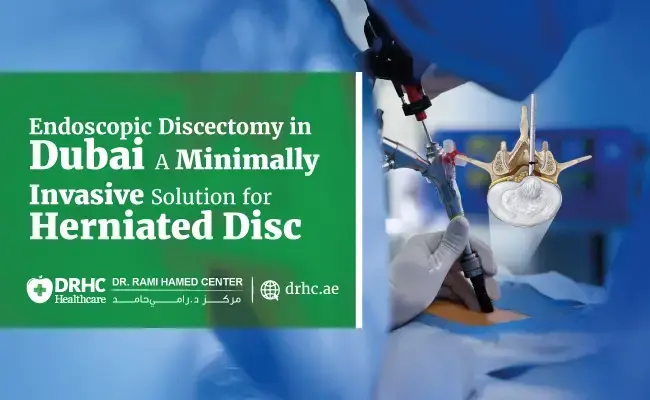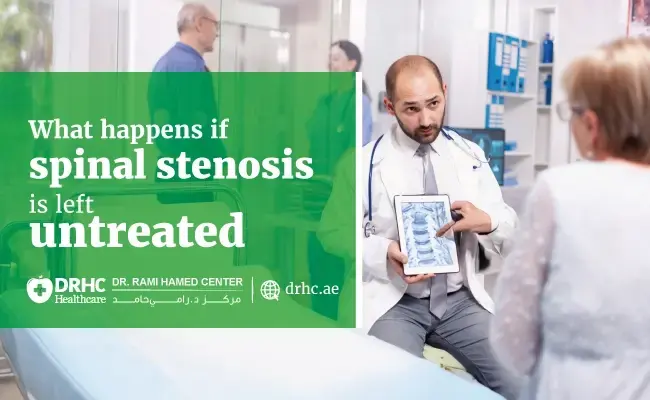
If you're experiencing pain, numbness, or weakness in your legs that worsens when walking and improves when sitting or bending forward, you're not alone. These symptoms could be signs of a condition called neurogenic claudication, often caused by spinal stenosis. At Dr. Rami Hamed Center (DRHC) in Dubai, we understand how distressing and limiting this condition can be. Our goal is to help you understand what’s happening in your spine and guide you toward the safest, most effective treatment options available.
What Is Spinal Stenosis?
Spinal stenosis is a condition where the space within your spinal canal becomes narrowed, putting pressure on the nerves that travel through the spine. While it can affect any part of the spine, lumbar spinal stenosis (in the lower back) is the most common—and it’s often the culprit behind neurogenic claudication.
This narrowing can be due to:
- Age-related changes in the spine
- Herniated discs
- Thickened ligaments
- Bone spurs from osteoarthritis
Although some people have spinal stenosis and never experience symptoms, others may notice significant discomfort, especially during activities like walking or standing for long periods.
What Is Neurogenic Claudication?
Neurogenic claudication is a set of symptoms caused by nerve compression in the lower spine. The term “claudication” refers to cramping or pain that develops with movement—commonly in the legs—and eases with rest.
Common Symptoms Include:
- Pain or heaviness in the legs when walking
- Tingling, numbness, or weakness in the legs or feet
- Relief when sitting, bending forward, or leaning on a shopping cart
- Difficulty walking long distances
These symptoms can affect your quality of life, limiting your ability to enjoy everyday activities or even complete simple tasks. It’s not just about discomfort—it’s about maintaining your mobility, independence, and confidence.
Why Does Spinal Stenosis Cause These Symptoms?
As the spinal canal narrows, the nerve roots in the lumbar spine—which control movement and sensation in the legs—become compressed. This pressure is often aggravated when you're upright or walking, as this posture naturally reduces the space in the spinal canal even further.
However, bending forward or sitting opens up the canal, relieving the pressure on the nerves and easing symptoms. That’s why many patients find they can walk farther if they’re leaning forward or using a walker or shopping cart for support.
How Is Neurogenic Claudication Diagnosed?
At DRHC Dubai, we start with a thorough clinical evaluation, reviewing your symptoms, medical history, and performing a neurological examination. To confirm spinal stenosis and evaluate the extent of nerve compression, we may recommend imaging tests such as:
- MRI (Magnetic Resonance Imaging) – Shows detailed images of the spinal canal and nerves
- CT scan – May be used if MRI is not an option
- X-rays – Helpful in detecting bone spurs or structural changes
What Are the Treatment Options?
We understand that facing a diagnosis of spinal stenosis can be overwhelming. Many patients worry that surgery is the only answer, but that’s not always the case. At DRHC Dubai, we take a step-by-step approach, focusing on conservative treatments first and guiding you carefully if surgery becomes necessary.
Nonsurgical Treatment Options:
- Physical therapy to strengthen back and leg muscles
- Pain management with anti-inflammatory medications or muscle relaxants
- Epidural steroid injections to reduce inflammation around the nerves
- Activity modification and the use of assistive devices like walkers
Many patients experience significant relief with a combination of these strategies.
When Is Surgery Considered?
If symptoms continue to worsen despite conservative treatment—or if your mobility is significantly impacted—surgical decompression may be recommended. This involves removing the tissue that’s compressing the nerves, such as part of a bone or a thickened ligament.
We understand that the idea of spine surgery can raise concerns. That’s why, at DRHC Dubai, we emphasize minimally invasive surgical options, faster recovery times, and personalized care plans tailored to your health and lifestyle.
Explore Our Related Blogs
- What to Expect During Recovery from Endoscopic Spine Surgery
- Who Is a Candidate for Minimally Invasive Spinal Surgery?
- How spine surgery relieves nerve compression and restores function
- How a herniated disc can lead to sciatica
FAQs: Your Common Concerns Answered
1. Is spinal stenosis a permanent condition?
Spinal stenosis is often chronic, but symptoms can be managed effectively with the right treatment plan.
2. Will I need surgery right away?
Not usually. Most patients respond well to conservative treatments. Surgery is typically considered only after other options have been explored.
3. How long is recovery after surgery?
Minimally invasive spine surgery can shorten recovery time. Many patients return to light activities within a few weeks
4. Can spinal stenosis cause paralysis?
Severe, untreated cases may lead to nerve damage, but paralysis is rare. Early diagnosis and treatment greatly reduce this risk.
5. Is walking safe if I have neurogenic claudication?
Yes, but it’s important to listen to your body. Walking with breaks, leaning forward, or using a support device may help ease symptoms.
Take the Next Step Toward Relief
If you’re dealing with leg pain, numbness, or walking difficulties, you don’t have to navigate this alone. At Dr. Rami Hamed Center (DRHC) in Dubai, our experienced spine specialists are here to help you regain comfort and confidence. We’ll work with you to build a treatment plan that fits your needs—whether that means physical therapy, pain relief, or advanced spine surgery.
Book a consultation at DRHC Dubai today and let’s take the first step toward a better quality of life.
Dr. Rami Hamed
Consultant Spine & Orthopedic Surgeon
Founder, DRHC – Dubai Healthcare City
📞 +971 4 279 8800
🌐 www.drhc.ae
📍 Dubai Healthcare City, Building 52
Topic: orthopedic Spine Surgery




.jpg)




Leave a comment